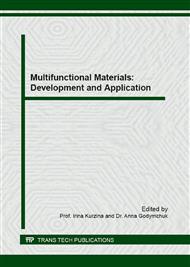[1]
J.H. Huang, Gaseous hydrogen embrittlement of a hydrided zirconium alloy, Metal. Mater. Trans. A. 29 (1998) 1047-1056.
DOI: 10.1007/s11661-998-1014-0
Google Scholar
[2]
T. Murakami, H. Mano, K. Kaneda, M. Hata, S. Sasaki, J. Sugimura, Friction and wear properties of zirconium and niobium in a hydrogen, Envir. Wear. 268 (2010) 721-729.
DOI: 10.1016/j.wear.2009.11.022
Google Scholar
[3]
S.V. Ivanova, Effect of hydrogen on serviceability of zirconium items VVER and RBMK-type reactors fuel assemblies. Int. J. Hydr. Energ. 27 (2002) 819-824.
DOI: 10.1016/s0360-3199(01)00160-4
Google Scholar
[4]
Y. Gou, Y. Li, H. Chen, Evaluation of a delayed hydride cracking in Zr–2. 5Nb CANDU and RBMK pressure tubes, Mater. Design. 30 (2009) 1231-1235.
DOI: 10.1016/j.matdes.2008.06.011
Google Scholar
[5]
N.S. Pushilina, V.N. Kudiiarov, R.S. Laptev, A.M. Lider, A.D. Teresov, Microstructure changes in Zr-1Nb alloy after pulsed electron beam surface modification and hydrogenation, Surf. Coatings. Technol. (2015).
DOI: 10.1016/j.surfcoat.2015.07.082
Google Scholar
[6]
K.R. Silva, D.S. DosSantos, A.F. Robeiro, L.H. Almedia, Hydrogen diffusivity and hydride formation in rich-zirconium alloys used in nuclear reactors, Def. Dif. For. 297-301 (2010) 722-727.
DOI: 10.4028/www.scientific.net/ddf.297-301.722
Google Scholar
[7]
M. Steinbruck, Hydrogen absorption by zirconium alloys at high temperatures, J. Nucl. Mat. 334 (2004) 58-64.
Google Scholar
[8]
N.S. Pushilina, A.M. Lider, V.N. Kudiiarov, I.P. Chernov, S.V. Ivanova, Hydrogen effect on zirconium alloy surface treated by pulsed electron beam, J. Nucl. Mat. 456 (2015) 311-315.
DOI: 10.1016/j.jnucmat.2014.10.006
Google Scholar
[9]
B. Cekic, K. Ciric, M. Lordoc, M. Smilja, M. Mitric, D. Stojic, Kinetics of hydrogen absorption in Zr-based alloys, J. Alloys. Compd. 559 (2013) 162-166.
Google Scholar
[10]
N.S. Pushilina, V.N. Kudiiarov, A.M. Lider, A.D. Teresov, Influence of surface structure onm hydrogen interaction with Zr-1Nb alloy, J. Alloys. Compd. 645 (2015) S476-S479.
DOI: 10.1016/j.jallcom.2014.12.078
Google Scholar
[11]
K. Young, J. Nei, The current status of hydrogen storage alloy development for electrochemical applications, Mat. 6 (2013) 4574-4608.
DOI: 10.3390/ma6104574
Google Scholar
[12]
W-K. Hu, X-P. Gao, Y. Kiros, E. Middelman, D. Noreus, Zr-based AB2-type hydrogen storage alloys as dual catalysts of gas-diffusion electrodes in an alkaline fuel cell, J. Phys. Chem. B. 108 (2004) 8756-8758.
DOI: 10.1021/jp0486548
Google Scholar
[13]
S-M. Lee, H. Lee, J-H. Kim, P.S. Lee, J-Y. Lee. A study on the development of hypo-stoichiometric Zr-based hydrogen storage alloys with ultra-high capacity for anode material of Ni/MH secondary battery. J. Alloys. Compd. 308 (2000) 259-268.
DOI: 10.1016/s0925-8388(00)00896-3
Google Scholar
[14]
R. Laptev, A. Lider, Yu. Bordulev, V. Kudiiarov, G. Garanin, Hydrogenation-induced microstructure changes in titanium, J. Alloys. Compd. 645 (2015) S193-S195.
DOI: 10.1016/j.jallcom.2014.12.257
Google Scholar
[15]
V.N. Kudiiarov, L.V. Gulidova., N.S. Pushilina, A.M. Lider, Application of automated complex Gas Reaction Controller for hydrogen storage materials investigation, Adv. Mater. Res. 740 (2013) 690-693.
DOI: 10.4028/www.scientific.net/amr.740.690
Google Scholar
[16]
D. Broom, Hydrogen storage materials. The characterization of their storage properties, 2011, XII, 260 p., Hardcover. ISBN: 978-0-85729-220-9.
Google Scholar
[17]
R.S. Laptev, Y.S. Bordulev, V.N. Kudiiarov, A.M. Lider, G.V. Garanin, Positron annihilation spectroscopy of defects in commercially pure titanium saturated with hydrogen, Adv. Mater. Res. 880 (2014) 134-140.
DOI: 10.4028/www.scientific.net/amr.880.134
Google Scholar
[18]
Y.S. Bordulev, R.S. Laptev, V.N. Kudiiarov, A.M. Lider, Investigation of commercially pure titanium structure during accumulation and release of hydrogen by means of positron lifetime and electrical resistivity measurements, Adv. Mater. Res. 880 (2014).
DOI: 10.4028/www.scientific.net/amr.880.93
Google Scholar
[19]
J.K. Nørskov, F. Besenbacher, J. Bøttiger, B.B. Nielsen, A.A. Pisarev, Interaction of hydrogen with defects in metals: interplay between theory and experiment, Phys. Rev. Lett. 49 (1982) 1420-1423.
DOI: 10.1103/physrevlett.49.1420
Google Scholar
[20]
J.M. Campillo, E. Ogando, F. Plazaola, Positron lifetime calculation for the elements of the periodic table, J. Phys. Condens. Matter. 19 (2007) 176222.
DOI: 10.1088/0953-8984/19/17/176222
Google Scholar


